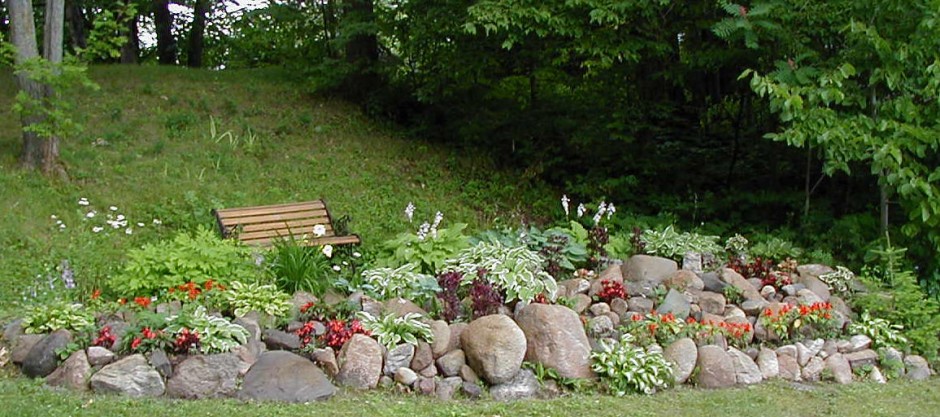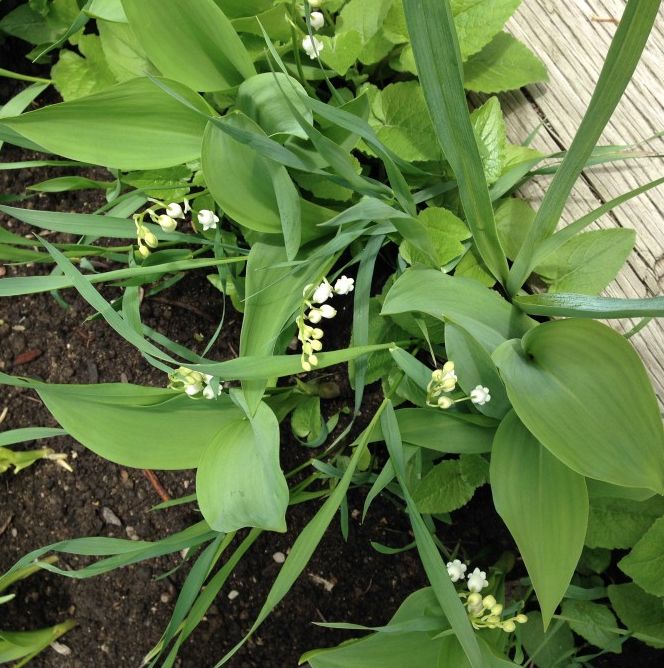 Shady rock garden
Shady rock garden
Some gardeners think that any rock garden needs lots of sunlight, while it is easy to make your own rock garden in the shadows if the plants are properly selected. Make your garden attractive and vigorously blooming!
Be creative and not only use alpine plants but also other ones capable to grow in the shadows. Shady plants for traditional gardening are taller and bigger than their sun-loving relatives. They look great against the stone: granite boulders, pieces of limestone and the river rock, but if you plant too many of such big shady plants, they will cover the beauty of the stone, and the stone will just sink in them. Observe the balance between larger plants, small plants, groundcovers, and stone.
Rocks for a shady garden and how to arrange them
We are creating a shady rock garden, so the natural beauty of the stone shall be well visible among the plants. They should tower above the plant, but not due to being at a higher level. Proper choice of the plants shall expose the beauty of the stone.
A shady rock garden looks better in the form of a gently sloping hill. If the slope is too steep (which is possible and may create a base for an interesting design), place big slabs of stone or boulders to prevent soil wash-out from the garden. It is particularly important before the plants have grown up to protect the soil from washing out. You can arrange stones in irregular circles at the levels of the hill. Alternatively, be creative and use your own ideas.
The nature is the best teacher in arranging the stones and planting the plants. To follow the nature it is recommended to create a rock garden from similar material: round granite boulders, that remember Glacier period or pieces of limestone. The latter are easily weathered so they will look pretty old in a year or two. You can plant miniature ferns into the cracks of the limestone.
As a ground cover pea stone is used instead of mulch. It looks as if it was naturally brought by the water. It prevents the soil drying, wash out and weeds growth. Big and small river rocks can be used to cover a dry river bed. You can make the dry river bed to direct water from a house roof into a lower part of the rock garden. If there is much water coming from the roof, you can make a small pond. Put some mossy stones around the pond to follow the nature.
Pay attention to the space between the rocks which have to be to be filled with fluffy, well-draining soil. Adding coarse sand or coir will improve the drainage. Adding coir will also improve water retaining abilities of the soil: coir retains lots of water but not excessive amounts of water. It also retains enough air for the roots growth.
In the shadow, the rocks will become mossy with time that will add more charm to the garden. To accelerate the process you can buy mossy rocks from us. Mosses propagate themselves with airborne spores, so more rocks around will be mossy.
Plants for shady rock garden
Beautiful flowers make any garden attractive, but most of them appear in spring or early summer, and then the blooming stops, leaving the garden without bright blossom accents. You want to admire the garden all the year round! Consider plants with decorative foliage and play with their different shapes, shades and colors. It will keep the shady rock garden impressive in the fall time when there are not many flowers. For example, hostas (with large dark green leaves) and ferns (having lacy tender light green leaves) create beautiful contrast due to forms and shades of their leaves. Small astilbes and dicentras also create good contrast with hostas. Plan both blooming and foliage plans for your shady rock garden.
Many grasses stay green from early spring to winter. Apart from ornamental grasses among the stones, consider making a frame of turf grass around your rock garden, especially if it is small. Choose a good shade grass mix for it.
Blooming shady plants
Dicentra (bleeding heart). This charming plant with heart-shaped flowers likes shadow as no one else. If growing in the shadow, it starts blooming late, but the blossom lasts until the end of summer.
The white trillium, our province floral emblem, feels good only in well-drained soil. So do other trilliums that may have blossom of other colors. Excessive moisture is dangerous for them. If the soil in your garden is not well enough drained, you better not plant trilliums, they will not survive. Improve your soil first by adding some coarse sand or coir. Trilliums like shadows and reasonable watering. They bloom from late May to early June.
Lily-of-the-valley tender white blossoms have a delicate, unforgettable scent that made this tiny flower an unforgettable memory of my childhood. It blooms from May to June. It is a poisonous plant, but harmless if not eating it. Lily-of-the-valley likes fertile soil. This plant is not native to the American continent and trends to be invasive if not kept at bay. Take care it does not escape from your garden to the natural environment.
Primula blooms very early and it is low maintenance. It grows gladly in shady and wet areas with fluffy soil. The bright yellow flowers appear early in spring, at the beginning of April. This plant will decorate any area and fit into any existing landscaping.
Aquilegia (Granny's Bonnet or Columbine) is a low maintenance shady plant, and it deserves to be planted in the foreground the rock garden due to its miniature flowers and gorgeous transparent silhouette. This modest beauty does not trend to invade more space than it is allotted and lack permanent sunlight does no harm to it. The bell-shaped flowers may be of diverse colors and shades: from white to ultra-marine.
Astilbe simplicifolia feels good in rich, moist soil. It is a dwarf species of astilbe that is native to Japan.
Cypripedium (Cyp, slipper orchid, lady's slipper, moccasin flower). There are 58 species and natural hybrids of this legendary flower, most of them perform well under the trees.
Anemone nemorosa (wood anemone, windflower) is a small plant blooming white in spring.
Fritillaria camschatcensis (Kamchatka fritillary) tolerates shade but prefers having some of the direct sunlight during the day.
Foliage plants for shady rock garden
Hosta. Bergenia. Heuchera. Brunnera. Ajuga reptans (bugle, blue bugle, bugleherb). Vinca. Mitchella repens (partridge berry; perfect groundcover: evergreen, non-invasive and also having nice tiny flowers and berries). Cotoneaster horizontalis (evergreen, very nice when creeping over the stone also looks great in the fall due to glossy foliage and red berries).
When selecting perennials for your shady rock garden, make a plan and try to imagine how it will look in a couple of years, after every plant develops. That will help you to decide where and how many plants should be planted.
It is good to arrange a bench near your shady rock garden to have a peaceful break on a hot sunny day.
2015 -2020 Alla Khandoga




Back To News

